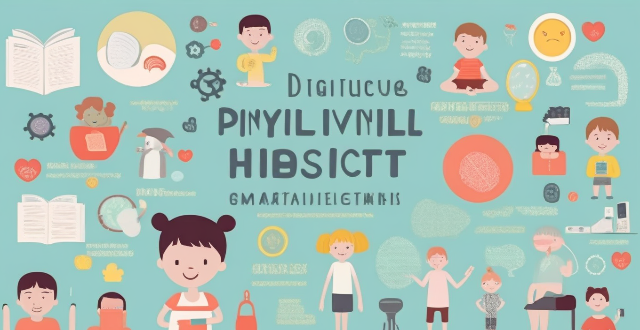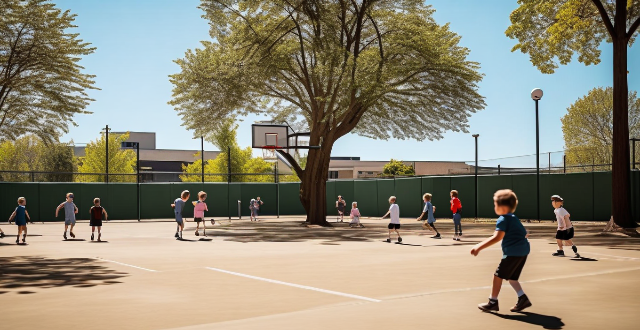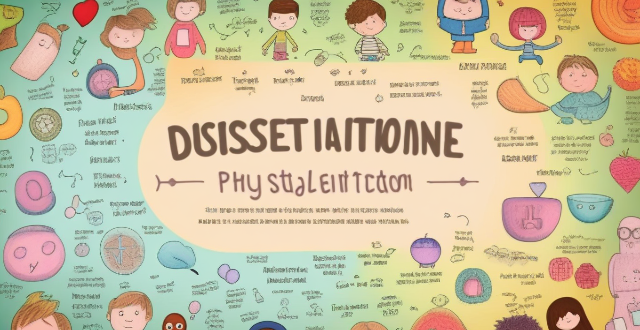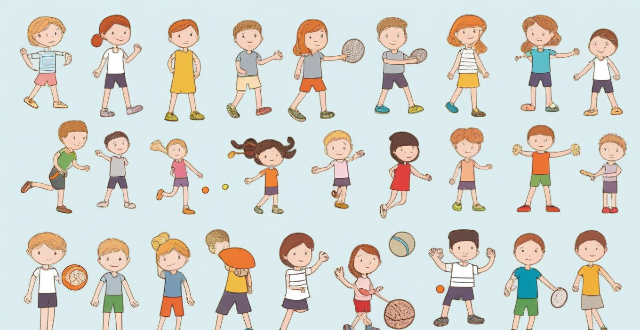Children Activity

How does physical activity affect children's cognitive development ?
This article discusses the positive impacts of physical activity on children's cognitive development, including improved attention and memory, enhanced executive functioning, increased learning abilities, reduced stress and anxiety, and promoted socialization and teamwork skills. Regular exercise can enhance blood flow to the brain, strengthen neural connections in the prefrontal cortex, stimulate neurogenesis, release endorphins, and provide a healthy outlet for releasing energy and emotions. Encouraging children to engage in regular physical activity can have long-lasting positive effects on their overall well-being and success throughout life.

Is there a link between childhood obesity and lack of physical activity ?
The article discusses the link between childhood obesity and lack of physical activity. It explains that childhood obesity is a growing concern worldwide, with an increasing number of children and adolescents being overweight or obese. Physical activity plays a crucial role in maintaining a healthy weight, and lack of physical activity is a significant risk factor for childhood obesity. Encouraging regular physical activity can help prevent and manage childhood obesity by promoting calorie burning, building muscle mass, and improving overall well-being.

In what ways can sports education foster a lifelong love of physical activity ?
The text discusses the role of sports education in promoting a lifelong passion for physical activity among children. It underscores the importance of making sports fun and enjoyable, offering choices, creating a supportive environment, improving fitness levels, building motor skills, developing sportsmanship, teaching teamwork, perseverance, discipline, and time management. The author emphasizes that sports education is essential for children's overall development and encourages prioritizing it in schools and communities to foster healthier, happier lives filled with lifelong love for physical activity.

How to choose the right extracurricular activity for your child ?
Choosing the right extracurricular activity for your child is crucial for their development and well-being. Consider your child's interests, skills, and abilities, evaluate the time commitment and logistics, seek recommendations and read reviews, and involve your child in the decision-making process to help them choose an activity they will enjoy and benefit from.

How can parents promote healthy developmental milestones in their children ?
This article provides tips for parents on how to promote healthy developmental milestones in their children, including providing a stimulating environment, encouraging social interaction and physical activity, teaching self-care skills, and fostering independence.

How can parents encourage their children to develop new skills through interactive activities ?
The article provides strategies for parents to encourage their children's skill development through interactive activities. It emphasizes the importance of hands-on, engaging learning experiences and offers specific tips for creating a supportive environment, involving children in planning, modeling behavior, offering praise, making learning fun, allowing for trial and error, providing practice opportunities, connecting learning to real life, and being patient and persistent. The goal is to help children become well-rounded individuals who are motivated and equipped for future challenges.

How can parents encourage their children to be more active ?
Parents play a significant role in encouraging their children to be more active. Here are some ways to do so: 1. Set an example by being active and engaging in physical activities regularly. 2. Create a supportive environment by providing access to sports equipment and encouraging outdoor play. 3. Make physical activity fun by finding activities that your child enjoys and using games and challenges. 4. Help your child set realistic goals for their physical activity and celebrate achievements along the way. 5. Limit screen time and encourage alternative activities instead. 6. Involve your child in household chores such as cleaning, gardening, or cooking to build strength, coordination, and endurance while teaching responsibility and teamwork.

How does exercise influence social skills in children ?
Exercise plays a crucial role in shaping children's social skills by enhancing communication, empathy, emotional intelligence, resilience, problem-solving abilities, healthy risk-taking, and leadership skills. Physical activity helps children build self-confidence, promotes teamwork, develops empathy, enhances emotional intelligence, increases resilience, enhances problem-solving abilities, encourages healthy risk-taking, and fosters leadership skills. These skills are essential for establishing positive relationships with peers and contributing to their communities. Therefore, it is imperative to encourage children to engage in regular exercise to support their overall development and success in life.

How does physical activity impact public health policies ?
The text discusses the importance of physical activity in promoting individual and public health. It outlines how regular exercise can prevent chronic diseases, improve mental health, and aid in weight management. The text then explains how these benefits influence public health policies, including the development of programs promoting physical activity, funding for research, and public awareness campaigns. Overall, it emphasizes the need for governments to promote physical activity through various initiatives, aiming to create a society where being active is a way of life.

Are there specific sports that improve academic performance in children ?
The article discusses the potential benefits of different types of sports on academic performance in children. It highlights team sports like basketball, soccer, and volleyball for their ability to teach social skills, time management, and discipline. Individual sports such as swimming, tennis, and gymnastics are noted for promoting self-discipline, goal setting, and mental toughness. Outdoor sports like hiking, cycling, and rock climbing are mentioned for providing physical activity, stress relief, and exploration opportunities. The conclusion emphasizes the importance of considering individual differences among children when encouraging sports participation for academic improvement.

Is there a connection between physical fitness levels and academic performance in children ?
This text discusses the potential correlation between physical fitness levels and academic achievement in children, highlighting research findings that suggest a positive relationship. It outlines various mechanisms through which physical activity may improve cognitive functions and behavior, leading to better academic performance. The text also emphasizes the importance of incorporating physical education into school programs and encourages family and community involvement in promoting physical activities among children.

What are the best home teaching strategies for children with ADHD ?
The article presents a comprehensive guide on effective home teaching strategies for children with ADHD, emphasizing the importance of structured routines, distraction-free environments, task breakdown, time management tools, incorporation of movement breaks, visual aids, immediate feedback, and open communication. These strategies aim to enhance focus, reduce anxiety, and improve overall academic performance and well-being for children with ADHD.

What strategies can help children develop good sleep habits ?
This article discusses strategies to help children develop good sleep habits, including establishing a consistent bedtime routine, creating a comfortable sleep environment, limiting screen time before bed, encouraging physical activity during the day, and maintaining a healthy diet. These habits are crucial for children's growth and development, leading to better physical health, improved cognitive function, and emotional stability. Parents should be patient and persistent in implementing these strategies, as it may take time for them to become established.

How does sports participation influence self-esteem in children ?
Sports participation has a positive impact on children's self-esteem by increasing physical fitness, developing skills and mastery, promoting social interaction and teamwork, and encouraging goal setting and achievement.

How do public health policies encourage individuals to engage in regular physical activity ?
Public health policies play a crucial role in promoting regular physical activity among individuals. They create awareness about its benefits, provide accessible facilities, offer incentives and subsidies, and integrate physical education into school programs. These efforts improve individual health and contribute to the overall well-being of society.

In what ways do public health policies address issues related to sedentary lifestyles and lack of physical activity ?
Public health policies aim to combat sedentary lifestyles and promote physical activity through various strategies, including education campaigns, environmental changes, workplace interventions, school programs, community initiatives, and legislative actions. These efforts target different settings such as schools, workplaces, and communities to encourage regular exercise and reduce prolonged sitting or inactivity. By making physical activity a part of daily life, these policies seek to improve overall health outcomes and decrease the incidence of chronic diseases related to sedentary behavior.

In what ways do sports help with emotional regulation in children ?
Engaging in sports can significantly aid children in developing emotional regulation skills by promoting stress reduction, enhancing self-esteem, developing resilience, encouraging teamwork and social interaction, teaching discipline and self-control, providing an outlet for energy, and promoting mindfulness.

What are the benefits of participating in team sports for children ?
Participating in team sports for children offers benefits including improved physical health, psychological well-being, social skills development, life skills acquisition, and educational advantages. These activities enhance cardiovascular health, self-esteem, teamwork, discipline, and academic performance. Overall, team sports provide a comprehensive developmental experience that prepares children for success in various life aspects.

What strategies can help children stay motivated during home learning ?
In conclusion, keeping children motivated during home learning requires a combination of strategies such as setting clear goals, providing feedback and recognition, creating a supportive environment, using technology wisely, and encouraging self-directed learning. By implementing these strategies, parents and educators can help children stay engaged and focused during home learning sessions.

Are there any bike trails suitable for families with children ?
Cycling is a great way to spend quality time with your family while enjoying the outdoors. However, finding the right bike trail that is suitable for families with children can be challenging. In this article, we will explore some of the best bike trails for families with children. Before embarking on a family cycling adventure, it's essential to take certain safety precautions. Here are some tips to keep in mind: ensure that everyone wears a helmet and appropriate protective gear; choose a trail that matches the skill level of all family members; carry plenty of water and snacks for everyone; bring a first aid kit and a fully charged mobile phone; let someone know your planned route and expected return time. Some popular rail trails include the Great Allegheny Passage and the High Bridge Trail. Many parks offer dedicated cycling paths that are suitable for families with children, such as Central Park Loop and Stanley Park Seawall. City bike paths like Boulder Creek Path and Bike Score are also great options for families.

How can schools and communities create inclusive sports programs for children with disabilities ?
Inclusive sports programs are important for children with disabilities. To create such programs, schools and communities should assess community needs, develop policies and procedures, train coaches and staff, modify facilities and equipment, offer modified sports programs, promote inclusion and participation, and evaluate and improve continuously. This ensures equal opportunities for children with disabilities to engage in physical activities and personal growth while fostering a sense of belonging and inclusion.

How can parents effectively teach their children about safety ?
Teaching children about safety is crucial for their well-being. Parents can effectively teach their children about safety by establishing clear rules, educating them about potential dangers, practicing safety drills, encouraging open communication, and modeling safe behavior. By doing so, children will develop awareness and the ability to protect themselves from potential dangers.

How does hydration affect physical activity ?
Hydration is crucial for physical activity, affecting performance, endurance, and well-being. It regulates body temperature through sweating and heat tolerance, supports energy production and recovery, lubricates joints, maintains blood volume for heart function, and ensures mental clarity. Dehydration can lead to decreased performance, impaired thermoregulation, cardiovascular strain, and reduced cognitive abilities. To maintain hydration during physical activity, strategies include pre-activity hydration, regular fluid intake during exercise, post-activity rehydration, electrolyte balance, monitoring urine color, listening to thirst signals, and avoiding diuretics.

How do I provide for minor children in my estate plan ?
When it comes to estate planning, one of the most important considerations is how to provide for your minor children. Here are some steps you can take to ensure that your children are taken care of financially and emotionally after you're gone: Create a will or trust, name a guardian, establish a trust fund, consider life insurance, and make sure your beneficiaries are up-to-date.

How can children be encouraged to speak up if they feel unsafe ?
The article emphasizes the importance of creating a safe and supportive environment for children to express themselves without fear of judgment or criticism. It suggests educating children about personal safety, role-playing different scenarios, and discussing potential consequences of not speaking up if they feel unsafe. The article also recommends teaching children who to trust, encouraging them to use their voice, and providing options for seeking help. Overall, it highlights the significance of empowering children to take action and advocate for their own safety.

Can physical activity improve mental health ?
Physical activity has been found to significantly improve mental health by enhancing self-efficacy and stress self-management skills. Research shows that engaging in physical activities can lead to a sense of accomplishment, boosting an individual's confidence in their abilities, which in turn fosters better stress management and contributes to enhanced mental well-being. This relationship is particularly important for adolescents, a demographic vulnerable to mental health challenges. Future research should focus on identifying specific types of physical activities that have a greater potential to enhance these skills, guiding the development of targeted interventions aimed at improving mental health through physical activity.

What role do children play in combating climate change ?
The article emphasizes the pivotal role children can play in combating climate change. They can contribute through education and awareness, innovation and creativity, advocacy and action, and by making sustainable lifestyle changes. By empowering children to understand and act on climate issues, we can ensure a more sustainable future for all.